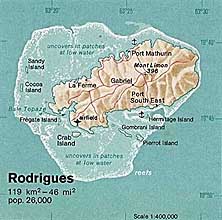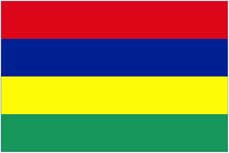-
-
- Mauritius Map
|
-
-
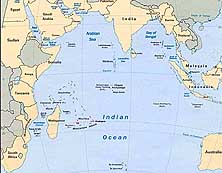
-
- Map of the Indian Ocean
|
|
-
|
- latest picture: July 2, 2011
|
|
-
-
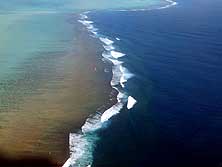
|
-
-

|
-
-
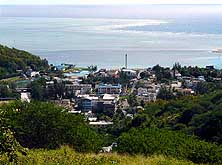
|
- 301
The reef with the deep sea on one and
- the shallow lagoon on the other side encircles
- the whole 42 square miles small island of
- Rodrigues. It belongs politically to Mauritius,
- has a certain autonomy and lies 360 miles
- East of the main island
|
- 302
On June 25th, 2011, we land
- with a propeller aircraft of Air Mauritius
- at the Sir Gaetan Duval airport in the
- West of the island, because the
- freighter with our LandCruiser is
- arriving one week late in Mauritius
|
- 303
View over Port Mathurin, the
- main city. There are two small
- supermarkets, four restaurants
- and one gasoline station,
- the only one on the island
|
-
- It is Saturday, June 25th, 2011. Full of expectations we peek out of the plane – a
twin-engined ATR72 – at the deep blue Indian
Ocean. Beneath us the white crests of the reef form a clear line against a turquoise
shimmering lagoon – the lagoon that encircles the island of Rodrigues that lies 360
miles East of the main island of Mauritius. Shortly
afterwards the completely full propeller aircraft of Air Mauritius makes a rather bumpy
landing at the small Sir Gaetan Duval airport of Rodrigues Island.
|
-
-
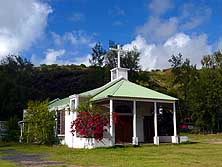
|
-
-
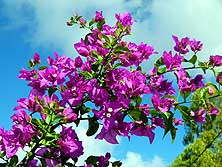
|
-
-
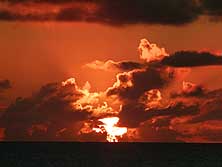
|
- 304
The village church of Grand Baie,
- 3 miles East of Port Mathurin with
- its rural charm
|
- 305
The colorful Bougainvilleas
- are always an eye-catching sight
|
- 306
A special show:
- Sunset at Grand Baie
|
-
- Though this 42 sq.mi. small island with its 38’000 inhabitants belongs politically
to Mauritius, it is autonomous in certain sectors. Hence we have to fill out a new entry
form, and also the customs manifests with its presence that it has a saying too. The
island has been named after the Portuguese seafarer Diego Rodrigues, who discovered it in
February 1528.
|
-
-
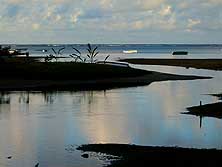
|
-
-
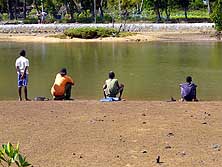
|
-
-
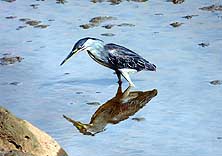
|
- 307
The evening mood at Grand Baie, where
- we rented a small studio, is always peaceful
|
- 308
Who is catching the first fish?
|
- 309
It needs a lot of patient
- to get a bite to eat!
|
-
- Where are we actually, we ask ourselves when we drive by taxi from the airport to the
Eastern part of the island, where our guesthouse “Le Benitier” is situated at
Grand Bay. The landscape that we cross is dry and stony in some parts. With its grazing
cows it looks rather like a Swiss alpine scene than a tropical area. However, the neat
villas that sit on the hills and the casuarina-lined sandy bays have a distinctive
Mediterranean character.
|
-
-
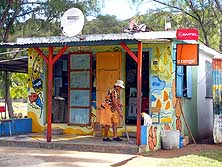
|
-
-
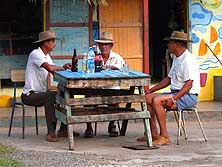
|
-
-
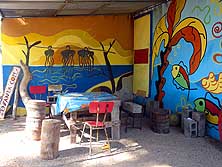
|
- 310
The tiny “mom-and-pop” store at Grand
- Baie reflects the unhurried island life …..
|
- 311
..... it is the gathering place for a
- cold beer and a chat with friends …..
|
- 312
..... the idyllic corner table is still
- empty. What a wonderfully relaxing spot!
|
-
- The inhabitants on the other hand are unmistakably of African origin. They are
descendants of slaves from Mozambique and speak Creole and French despite that their
official language is English. The climate again is comparable with a European summer. A
bit complicated, isn’t it? Despite that the Mauritian islands belong geographically
to Africa, it is not the „real” Africa though. But
this makes this small island in the Indian Ocean
so charming.
|
-
-
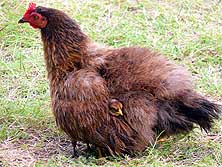
|
-
-
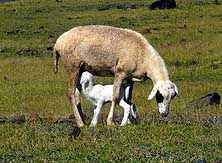
|
-
-
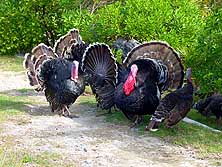
|
- 313
What is happening out there?
|
- 314
Grazing sheep add to the
- picture of this “stress free island“,
- how Rodrigues likes to call itself
|
- 315
Three turkey males
- compete to win the females favor
|
-
- But the people around us give us definitively the feeling that we have arrived in Africa
again. Their open friendly personality, their bright smiles and their unhurried way of
life are so typically of Africa. It still is exactly how we remember the Black Continent
from our four years crossing from North to South between 1989 and 1992. Their endless
patience is still legendary. Nobody gets upset that the bus does not run at a fixed
schedule and often one has to wait up to 40 minutes for the next one. Meanwhile they are
quite happy to chat with each other.
|
-
-
-
-
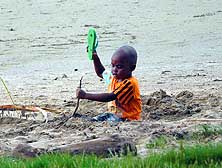
|
-
-
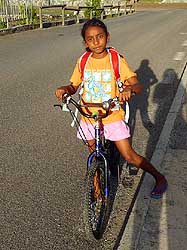
|
-
-
-
-
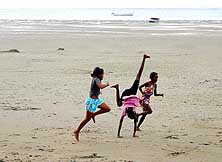
|
- Here, children do not need sophisticated toys
|
- 316
A small boy is happy to play in
- the sand with a flip-flop and a stick
|
- 317
A girl goes for a bike ride
|
- 318
Three girls are exercising
- handstands at the beach
|
-
- That is exactly what we also do while at the same time we watch the people around us:
The big mama’s clad in their typically bright skirts, the skinny old men in their
wide-brimmed straw hats and the cute school girls with their thin braids, colorful hair
ribbons and floppy hats who take the public bus to school. We have not seen any actual
school busses. But we are eyed too – where probably might these foreign westerners
come from?
|
-
-
-
-
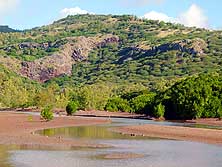
|
-
-
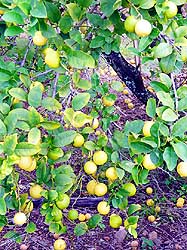
|
-
-
-
-
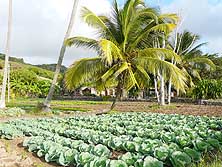
|
- 319
Rodrigues does not look tropically.
- The hilly island rather looks Nordic.
- Here at Grand Baie in the North
|
- 320
Limes grow in abundance
- – carpets of fruits are rotting
- on the ground
|
- 321
A rather unusual mixture: Palm
- tree and cabbage grow side by side
|
-
- In Grand Bay, where we rented a small studio for US$ 35 a night, we feel sort of
“at the end of the world”, or in other words “where they roll the sidewalks
up at night”. At least we find a mom-and-pop store, where we can get a fresh baguette
and beer. Luckily the friendly mama, who – together with her husband – runs the
nostalgic painted small shop at the casuarina-lined bay trusts us and sells us the beer
without handing in an empty bottle; if she doesn’t get back the empty bottle, she
faces a problem with the supplier to get new full bottles: Bottle exchange!
|
-
-
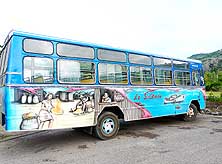
|
-
-
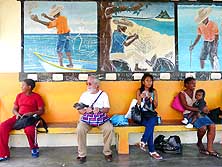
|
-
-
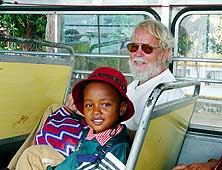
|
- 322
A nostalgic painted public bus
- depicting the scene of the arrival of
- the ancestors, who came
- from Mozambique …..
|
- 323
..... Emil is waiting patiently
- among other people at the bus
- terminal at Port Mathurin.
- There is no set schedule …..
|
- 324
….. a cute little girl sits next
- to him. School children take the local
- bus. There are no school buses
|
-
- The two battered tables outside the shop are also Grand Bay’s
“restaurant”. It is the place to meet for a beer at weekends, to play cards, to
have a snack or simply to chat with friends. There are no other eating places. The
“Maisons d’Hôtes” – the private guesthouses – cater for the
tourists and meals are taken together with the host and the family at the same table. This
is common in Rodrigues, and renting out rooms became an important income source. Apart of
it people live mainly from fishing, agricultural produce and some arts and crafts.
|
-
-
-
-
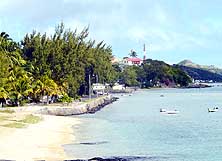
|
-
-
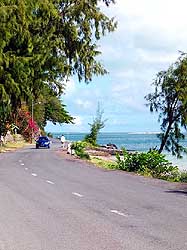
|
-
-
-
-
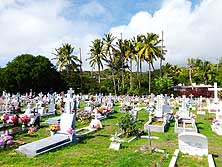
|
- 325
Peaceful coastal road from
- Grand Baie to Port Mathurin,
- ideal for a walk …..
|
- 326
..... traffic is very scarce
|
- 327
The well kept Christian cemetery
- of Anse aux Anglais East of Port Mathurin
- lies directly at the coastal road
|
-
- What we really enjoy are the slow pace of life and the solitude. On our evening walks
along the sea shore we hardly encounter a soul, only goats nibbling on the thorny acacia.
Only once an engine noise interrupts the deep tranquility. We are just taking pictures of
the colorful display of the sunset, when a car stops beside us. A friendly dark face
smiles at us from the window. It is a policeman. He is pleased to see us enjoying the
skies turning pink and purple and takes a moment to chat with us. “If you follow the
coast further, the scenery is getting even more beautiful” he recommends us with a
beaming face before he takes off. It is these spontaneous encounters – the taking
time for each other that makes Rodrigues so special. Rodrigues really deserves its
self-imposed name of “stress-free-island”.
|
-
-
-
-
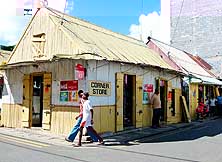
|
-
-
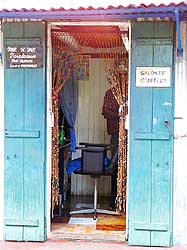
|
-
-
-
-
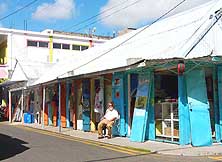
|
- 328
The nostalgic Corner Store at
- Port Mathurin recalls memories
- of Georgetown in Guyana
|
- 329
A hairdresser salon in
- Port Mathurin brings the “good
- old times” back into mind
|
- 330
Emil allows himself a little break
- from the Port Mathurin walking tour
|
-
- It is Monday morning. We take the bus to the main town of Port Mathurin. Even the
“capital” is reflecting the easygoing island’s life. There is no hectic, no
honking, there are no yelling sellers, there is nobody pushing us to buy something. We
stroll through the streets lined with stately trees and shady alleys and browse through
the small market and the little shops packed with all kind of goods. Seeing the nostalgic
“corner store”, a “hairdresser salon” from the good old times,
Rastafarians selling fruits at a market corner – the city of Georgetown in Guyana automatically emerges in front of our eyes. Like
there, life seems also here unchanged since decades.
|
-
-
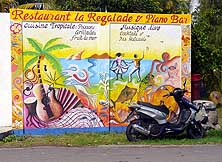
|
-
-
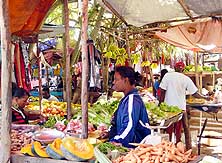
|
-
-
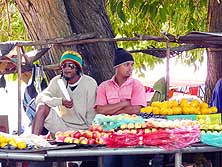
|
- 331
Who does not feel tempted to
- this fanciful ad of a tropical restaurant?
|
- 332
The choice of fresh fruits and vegetables
- is big at the market of Port Mathurin
|
- 333
A legendary duo is selling apples and
- oranges at the market place of Port Mathurin
|
-
- In Port Mathurin there are two middle sized supermarkets, four restaurants of which two
are currently closed for holidays and one gasoline station – the only one on the
island. Following Emil’s natural intuition for viewpoints we end up at “Rue
Mamselle Julie” from where we spot a broken stony stairway leading up the hill. Red
ripe pomegranates adorn the gardens of the little houses lining the stairway. At some
point, the stairs end at a house, guarded by an obviously nasty but chained dog snarling
ferociously at us. At least, the panorama of the harbor city comes already into view,
surrounded by greenery and the Indian Ocean.
|
-
-

|
-
-
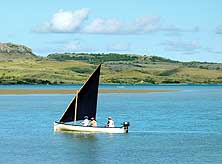
|
-
-
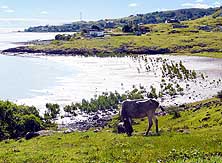
|
- 334
View over Baie Malgache
- in the West of Port Mathurin
|
- 335
A fishing boat hoists the sail at
- Baie du Nord, the departure point to
- the Cocos Island. The landscape towards
- the West looks rather brownish and arid
|
- 336
The "frazzled" Baie du Nord is
- dotted with young mangroves. The
- coastal road to the East ends here;
- we drive inland with our rented car
|
-
- On the 5th day, we decide to rent a car for the next two days at the travel agency in
town. We want to discover the lovely corners of the island for ourselves. The following
morning at 8am a shiny red Toyota pick-up is standing surprisingly punctual in front of
our studio in Grand Bay. When Emil wants to hop into the car and drive with the guy into
town to put the deal on paper, he refuses it with a smile and just hands him over the car
keys – contracts don’t (yet?) exist here. Where else in the world do you find
this unconditional confidence and relaxed attitude?
|
-
-
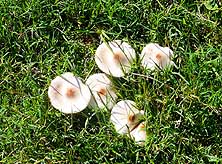
|
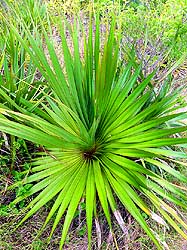
|
-
-
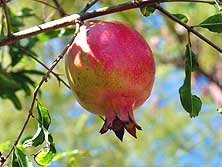
|
- 337
We enjoy the sight of these
- white mushrooms sprouting out
- of the green grass
|
- 338
Vacoas plants, also called Screw
- Pines (Pandanus vandermeerschii),
- endemic to Mauritius, belong to the
- Pandanus family. Baskets, bags and
- hats are woven from their fibers
|
- 339
The trees of the red-green
- pomegranate (Punica granatum)
- adorn the landscape.
- The fruit is edible
|
-
- The road is meandering peacefully through a rural scene – be it in the West, in the
East, in the North or in the South. And the turquoise sparkling lagoon that encircles the
whole island is never far away and is eye-catching from every hill. Following the many
access roads up hill and down dale along the countryside, the scattered hamlets, the
grazing cows, sheeps and goats give a rural touch to the scenery.
|
-
-
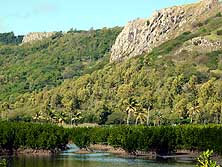
|
-
-
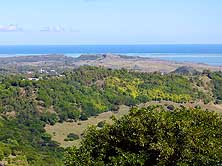
|
-
-
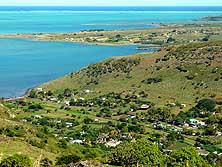
|
- 340
Mangroves along
- the Baie du Nord
|
- 341
View from Montagne Tonnerre
- towards the Southwest. In the fore-
- ground left the village La Ferme and
- in the back right the Cocos Island
- (Île aux Cocos)
|
- 342
View from Citron Donis to
- the village of Rivière Cocos
- on the South coast
|
-
- On one rooftop „draperies“ of Chinese pork sausages are dangling to dry in the
air. For Rp. 85 a pound (US$ 2.90) we buy some, but they are not what we hoped them to be.
They contain honey and sugar and therefore taste sweet. On another flat roof there are
yellow corncobs, and on a basic wooden frame five squids are left to dry on a stick
between two crutches – the rural charm is at every turn.
|
-
-
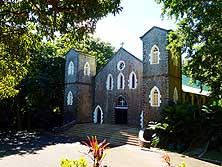
|
-
-
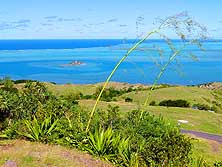
|
-
-

|
- 343
The St. Gabriel church stands in
- the middle of the island. As the biggest
- church in the Indian Ocean it holds
- 2’000 visitors. Still, during the visit of
- Pope John-Paul II to Rodrigues in 1989,
- the mass had to be celebrated on
- the soccer field of La Ferme
|
- 344
Two long stems of the Agave
- flower bend towards the turquoise
- Southern shore. Islands: Left in front
- Île Hermitage, therefrom right
- Île aux Chats, behind it Île Plate
- and far right Île Gombrani
|
- 345
The lonely modest house
- on grass covered hills above the
- South coast adds to the Nordic
- character of this island
|
-
- When we reach the East Coast, we are greeted by lovely white sandy beaches, lined by
casuarinas or every now and then by pandanus. From Anse Ally to Saint François there is
one after the other. Now they all are still deserted. The high season starts only in
November. Also at the Cotton Bay Resort in the Northeast we see just an elderly couple at
lunch. But just entering the hotel is a „light bulb moment“. The blue of the
pool melts into the blue of the ocean – simply an extraordinary sight, not for free
however: A room costs US$ 177 per person/night.
|
-
-
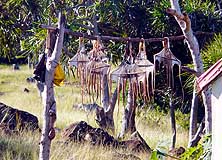
|
-
-
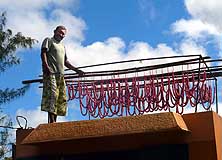
|
-
-
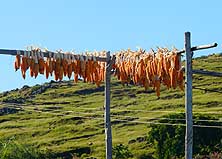
|
- The rural scene is evident
|
- 346
Squids are put on a line
- to dry in the air …..
|
- 347
..... “draperies“ of Chinese pork
- sausages dangle on the roof of a house.
- They contain honey and sugar giving
- them a sweet taste. One pound costs
- Rup. 94 = US$ 3.04 .....
|
- 348
….. yellow maize
- cobs hang in lofty heights
|
-
- Soon after, we are at the “François Leguat Giant Tortoise & Cave Reserve”
in Anse Quitor on the Southwest Coast. What an incredible sight it must have been 300
years ago when this island was still untouched and completely populated by turtles. Back
in 1691, it was the home of hundreds of thousands of these creatures. But after a century
of human exploitation and environment destruction, they became continuously reduced and
finally extinct.
|
-
-
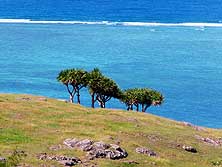
|
-
-
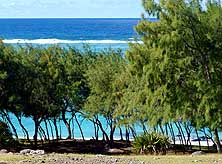
|
-
-
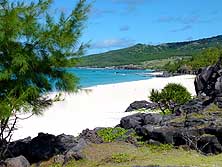
|
- 349
Pandanus trees are common. A
- solitary group lines the Eastern shore
|
- 350
Most of the beaches are dotted
- with Casuarinas providing wonderful
- shade against the sun. Here at the
- East coast at Anse Ally
|
- 351
The best sandy beaches on
- Rodrigues Island are found on the
- East coast: Here from
- Anse Ally to Saint François
|
-
- The extinction started in the days when freighters called at this island lying in the
middle of the Indian Ocean to take refuge from
storms and replenish their supplies of fresh water and fresh meat. The turtles being
defenseless and easy to handle and to nourish were very convenient. They could be kept
alive for months as meat supply on the ships.
|
-
-
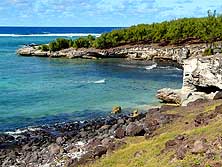
|
-
-
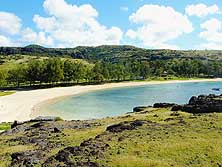
|
-
-
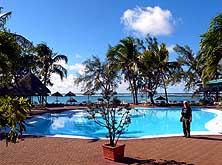
|
- 352
At Saint François in the East:
- A cliff coast interrupts the sandy beach
- to give later way to more sandy bays
|
- 353
The public beach at
- Saint François in the East
|
- 354
Stepping into the Cotton Beach
- Resort in the Northeast is a “light bulb
- moment”. Who can afford US$ 170
- per person/night. We cannot!
|
-
- Later the poachers with their greed of gain did the rest. It makes us so mad and sad:
Everyday we enjoy each creature, each plant, everything Mother Nature marvelously
produces. Then this selfish and irresponsible humans show up and destroy everything that
makes life on our planet worth living.
|
-
-
-
-
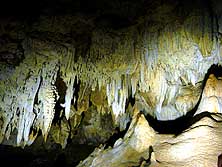
|
-
-
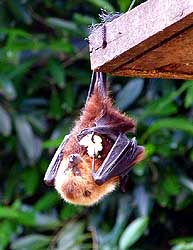
|
-
-
-
-
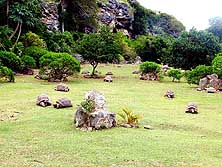
|
- François Leguat Giant Tortoise and Cave Reserve in the Southwest
|
- 355
Bizarre stalactites and stalagmites
- adorn the “Grand Caverne’ at the
- François Leguat Reserve in the South
- West. With its length of over 1’600ft.,
- it is the biggest of the eleven caves
- of the reserve
|
- 356
The Rodriguan fruit bat
- (Pteropus rodericensis) is endemic
- to the island. In the enclosure of the
- François Leguat Reserve we see a
- few of these golden-brown mammals
|
- 357
Giant turtles graze in the Tiyel
- Canyon of the Reserve. In the hundred
- of thousands back in 1691, they became
- extinct in Rodrigues due to human
- exploitation. With the breeding program,
- over 1’100 Aldabra- und Radiata-
- tortoises are now living in the reserve
|
-
- Well, thanks to the reputable breeding program in this 49 acres nature reserve over
1’100 giant Aldabra and Radiated tortoises, including 150 newborns, are living here
again. They are fostered and looked after very well. We are pleased to see how a young
lady is treating a sore skin with a red antiseptic.
|
-
-
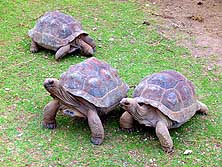
|
-
-
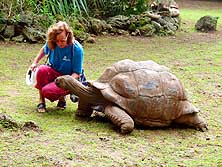
|
-
-
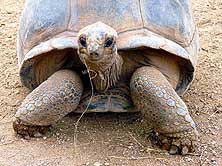
|
- François Leguat Giant Tortoise and Cave Reserve in the Southwest
|
- 358
Yes, we can get attached also
- to turtles, especially when they
- crawl towards us so trustingly …..
|
- 359
….. this giant Aldabra turtle
- obviously likes to be scratched at
- the neck by Liliana …..
|
- 360
..... who says that I
- don't look cute?
|
-
- Whose heart is not beating faster at the sight of the big numbers of turtles grazing
peacefully among the unique flora of the Tiyel Canyon that once covered the entire island?
It is so heart-warming when they crawl towards us so trustingly and lift their neck to be
scratched. The oldest Aldabra turtle weights 440 pounds and is over 100 years old. It is
just awesome to be standing next to such a „historic“ creature.
|
-
-
-
-
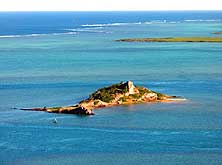
|
-
-
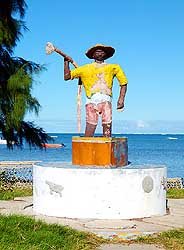
|
-
-
-
-
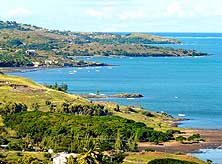
|
- 361
The tiny offshore rock on the
- South shore is the „Île Hermitage“
- – the “Eremite Island”
|
- 362
We like this monument in
- Port Sud Est at the Southern shore,
- but do not find out what it stands for
|
- 363
Typical for Rodrigues coasts are
- the many land tongues with scattered
- houses. Here in the South the arm
- of sea Anse Grande Var
|
-
- But not only turtles, also fruit bats (Pteropus rodricensis) live in an enclosure in the
nature reserve. It is the only endemic mammal found on the island. Unfortunately, we see
only a handful of these cute golden-brown animals, which were brought back from the verge
of extinction. In the 1970’s only 70 individuals remained and it became the
world’s rarest flying foxes. Now, the number has increased to several thousands,
though they are still regarded as an endangered species.
|
-
-
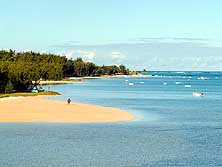
|
-
-
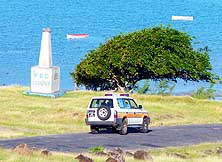
|
-
-
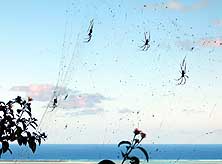
|
- 364
Casuarinas and tiny sandy
- bays line the coast at Anse Mourouk
- in the South
|
- 365
The police patrols also in the
- remotest corners of the island like
- here on the South coast
|
- 366
Phenomenal are the dozens of
- spiders hanging everywhere in huge nets
- woven between poles. It is a silk spider,
- the “red-legged golden orb-web spider”
- (Nephila inaurata)
|
-
- Much too soon we arrive at the second part of our tour, at the caves. This is one of the
reasons, why especially Emil is not very fond of a guided tour: You cannot determine your
own rhythm. Despite that exploring the 1’640 ft. long “Grande Caverne“
– one of eleven caves – with its impressive stalagmites and stalactites is
interesting, we would have preferred to spend more time with the tortoises. As animal
lovers, such encounters are always a most satisfying experience.
|
-
-
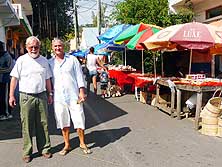
|
-
-
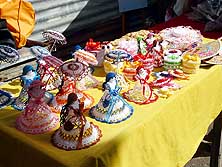
|
-
-
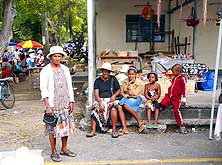
|
- 367
On this tiny island, we automatically
- see the same people all the time! Emil
- and Rene, a German living already
- eight months in Rodrigues
|
- 368
Lovely handicrafts are sold at
- the Saturday market in Port Mathurin
|
- 369
At the Saturday market in Port
- Mathurin a family is sitting in front of
- their booth with baskets and hats woven
- from dried “Vacoa” (Pandanus) leaves
|
-
- Our departure day, Saturday, July 2nd, 2011, closes in irreversibly. Our relaxed week on
the island is coming to an end. But we still have sufficient time in the morning to visit
the weekly Saturday market in Port Mathurin. While Emil is chatting with Rene, a German
living already eight months on Rodrigues but still dreaming of the Seychelles – his
last temporary stay, I am poking through the market stalls. They are filled to bursting
with fresh produce, but also with fine handicrafts – baskets and hats woven from
dried “Vacoa“ (Pandanus) leaves. From every corner black faces are smiling
towards me.
|
-
-
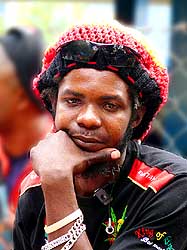
|
-
-
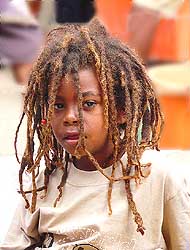
|
-
-
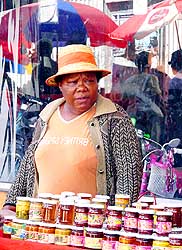
|
- 370
|
- 371
|
- 372
|
- Faces at the Saturday market at Port Mathurin that add the special colour to the place
|
-
- Three hours later, we are already sitting in the plane back to the Mauritius. Rodrigues was an interesting starting point for
our second African adventure, which continent we left in Cape
Town with wet eyes almost twenty years ago (November 2nd, 1992) for Australia
after having crossed it from North to South in four years. It puts us in the mood for
more! There is just one thing missing: Our faithful “travel companion”. It
finally arrived on July 1st, 2011, at the capital’s harbor of Port Louis on the main
island of Mauritius, having been 30 days at sea from Sri Lanka
via Malaysia and Réunion.
|
-
-

|
-
-
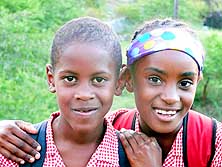
|
-
-
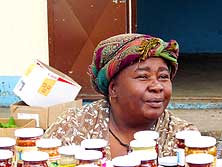
|
- 373
A girl is selling dried squid at the
- Port Mathurin’s Saturday market
|
- 374
Two school children are on
- their way home in Grand Baie
- and smile towards the camera
|
- 375
A mama is selling glasses of all
- kind of preserved homemade foodstuff
- like lemons, chilis, honey and pickles
|
-
|
| More websites
from Mauritius:
|
-
- Articles in newspapers about us in Mauritius:
- Article: "Le tour du monde en LandCruiser",
Daily Newspaper "Le Mauricien" - July 9, 2011
- Article: "Globe lovers",
Weekly Newspaper "Le Dimanche" - July 10, 2011
- Article: "Emil
et Liliana Schmid sur les routes à Maurice", Daily Newspaper "Le
Matinal" - July 12, 2011
|
![]()
